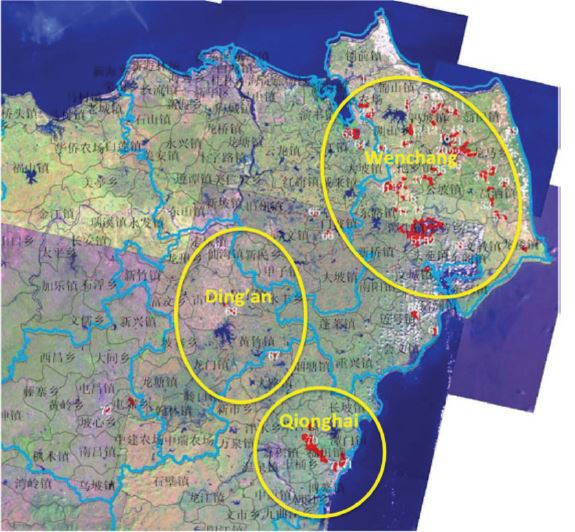3 Hainan Tilapia Aquaculture Improvement Project
Background
Hainan variously vies with its neighbour for the position of the number one tilapia production and export region in China. The tropical island at the southern
Figure 1. Location of Hainan province within P.R. China and location of main producing counties within Hainan.

Figure 2. Distribution of tilapia farms in the three main producing counties of Hainan.

tip of China produces around 340 000 tonnes of tilapia per year and exports most of this, with around 80 percent going almost equally to the U.S. and Europe. Production is in ponds, dams and cages across three counties in the north of the island. Wenchang has the highest volume and density of production, followed by Qiong Hai and Ding’An.
SFP’s initial engagement with the tilapia industry in China was at the request of a retail partner with a focus on farm-level certification. However, it soon became evident that there were bigger issues to tackle and no one really tackling them. With the support of the Packard Foundation and some industry interest, SFP established a pilot zonal Aquaculture Improvement Project in Hainan in 2011. Initial engagement with producers and processors around certification and broad studies assessing environmental impacts helped build relationships locally, but it is only in the last couple of years that the project has really taken off.
Key players in the local industry have understood the shared risks the industry is facing and the need for the industry to develop a unified voice. A desire to stand out as a responsible producer of a quality product has also helped to give the industry the confidence to take a lead. SFP continues to support what is now known as the Hainan Tilapia Sustainability Alliance (HTSA), driven by a group of leading local companies covering seed, feed, technical support, farming and processing, and increasingly involving more of the local industry.
Water Quality Management
The industry has faced the classical challenges of disease outbreaks particularly in the warmest months, but there has been little assessment of environmental impact. The ownership structure of many of these farms and the value placed upon water and nutrients means that many of the farms have very little discharge; however, balancing this desire to retain valuable resources with the need to maintain good water quality, particularly at times of high temperature, has led to innovation. Farmers typically discharge less than 10 percent of the total water held on farms each year.
Losses to evaporation are replenished, but the nutrientrich water is too valuable to flush to the environment and so is transferred from one pond to the next during the harvesting period. Many farms are situated within irrigation schemes, where water needs to be paid for.
Discharged water is usually used on agricultural crops where the additional nutrients are beneficial, but tilapia farmers are not rewarded for this.
Supporting Farmers
Farmers receive a range of technical and financial support, from commercial providers and from government extension officers. Commercial support comes from feed companies, hatcheries and processors, but a large part of the support to some farmers comes from the supplying and buying companies that support trade distribution—more classically known as middlemen.
Some of these middlemen are in fact sizeable businesses that have substantial stakes in the success of the industry. Leading middlemen companies provide expert advice in a timely manner, actively supporting farmers to ensure success. There are examples of such companies developing technical databases to enable farmers to refine their farming practices according to their local needs. This level of detail is helping to build real management in an industry that is still made up of a large number of small-scale producers.
Quality
The additional hook for the industry was identifying a shared ambition. Environmental sustainability is a noble goal and the idea of overcoming disease problems through collaboration with your neighbours is something that farmers understand, but find a challenge in reality. Such goals also put all the emphasis on farmers, when in fact there are many other players who are critical to the success of the overall industry. In Hainan the main driver to bring the industry together was a desire to identify themselves as different from all the other tilapia being produced in China, indeed in the world. Presenting their output as a quality product is a mechanism to engage all parts of the industry and makes use of the natural environmental quality of Hainan. This approach is certainly reminiscent of the Scottish salmon industry’s approach to setting itself apart from other producers. But the challenge for the tilapia industry in Hainan was how to build the mechanisms (both industry and regulatory) to ensure any claims of being a better product were backed up with identifiable actions.